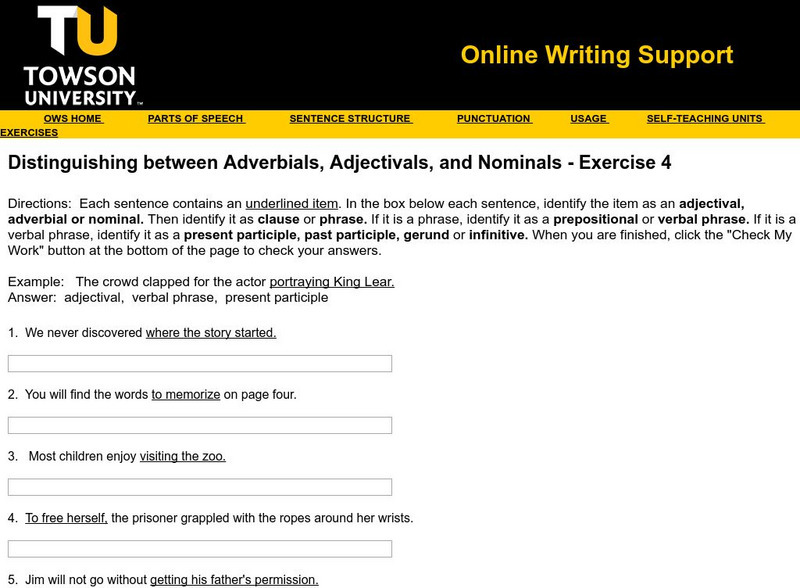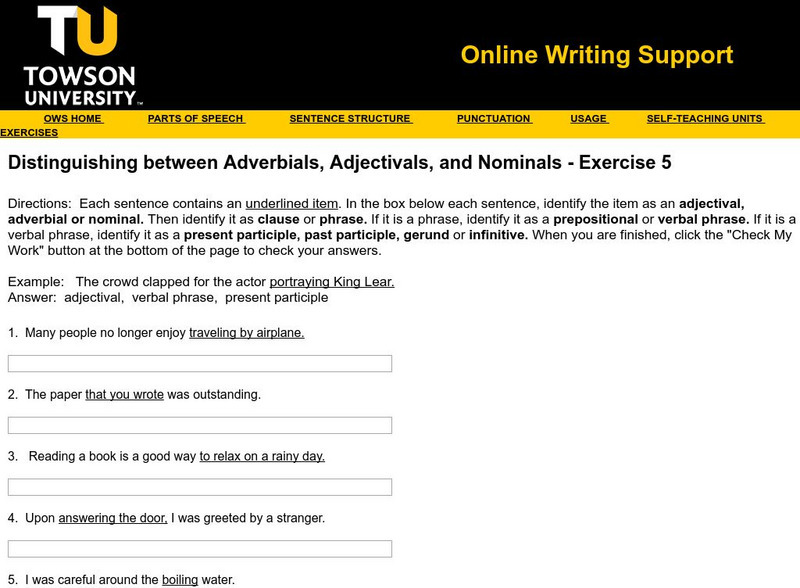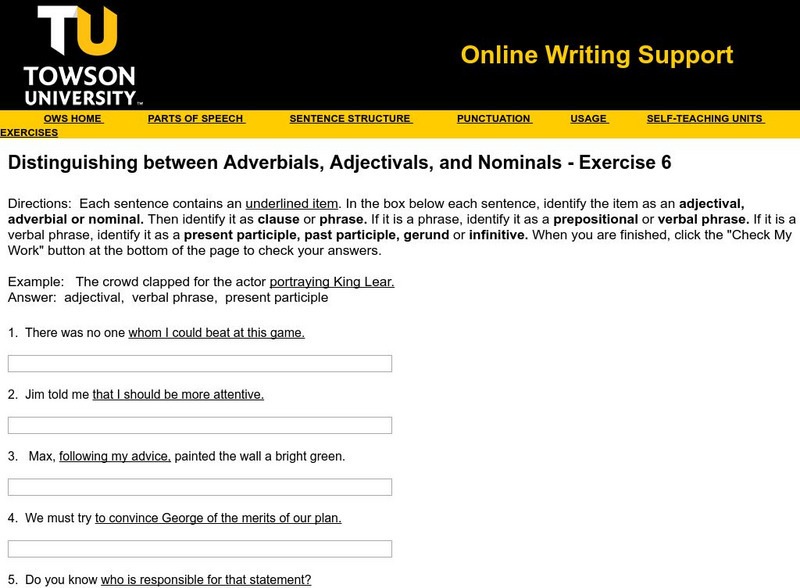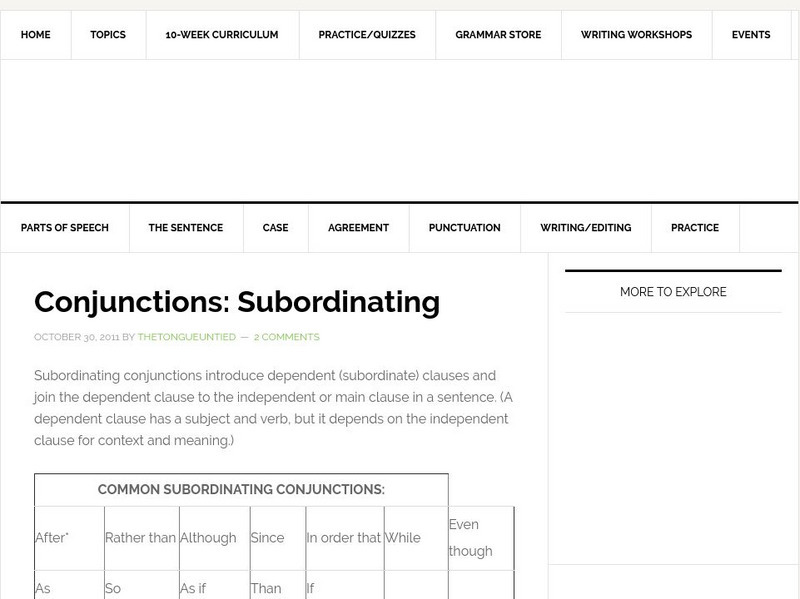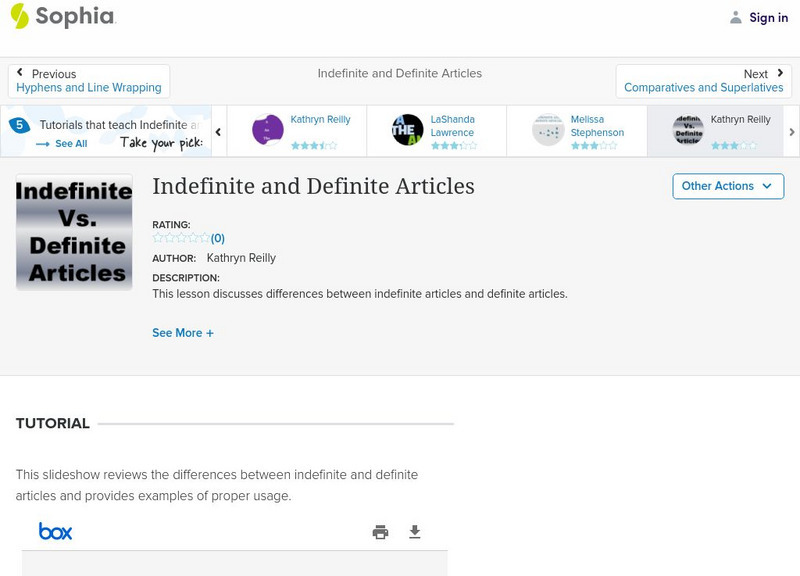Towson University
Towson University: Distinguishing Adverbials, Adjectivals, Nominals Exercise 4
This is a 20-question, self-grading quiz/exercise on Distinguishing between Adverbials, Adjectivals, and Nominals.
Towson University
Towson University: Distinguishing Adverbials, Adjectivals, Nominals Exercise 5
This is a 20-question, self-grading quiz/exercise on Distinguishing between Adverbials, Adjectivals, and Nominals.
Towson University
Towson University: Distinguishing Adverbials, Adjectivals, Nominals Exercise 6
This is a 20-question, self-grading quiz/exercise on Distinguishing between Adverbials, Adjectivals, and Nominals.
Philosophy Pages
Philosophy Pages: Categorical Syllogisms
Provides a detailed look at syllogisms. Sections include the following: "The Structure of Syllogism," "Standard Form," "Form and Validity," and "Diagramming Syllogisms."
Other
Writing More Persuasively
This site is very thorough, and offers two printable .pdf pages of some important points.
Other
Critical Reading: Subject and Predicate
Part of a larger site on "The Fundamentals of Critical Reading and Effective Writing," this section on the simple sentence focuses on the subject and the predicate. Definitions and examples are provided along with a section on...
Other
Colgate University: Clauses, Conjunctions, and Punctuation
This grammar tutorial explains constructing sentences using independent and dependent clauses with correct punctuation.
Other
Cayuga Community College: Clauses, Phrases, and Commas [Pdf]
Learn about phrases, dependent and independent clauses, and how to use commas appropriately with clauses and phrases.
University of Victoria (Canada)
The U Vic Writer's Guide: Grammar: Clauses
This site discusses the two main types of clauses. Content includes instructions for and examples of using clauses to build different types of sentences and information on recognizing types of clauses.
University of Richmond
University of Richmond: Using Transitions
A discussion of how to use transitions for effective writing. W.9-10.2c cohesion/clarity/trans, W.11-12.1c Transitions/Cohesion, W.11-12.2c Transition/Cohesion CCSS.ELA-Literacy.WHST.6-8.2.c
University of Richmond
University of Richmond: Transitional Words and Phrases
This site has a list of transitional words and phrases organized by their function in a sentence or paragraph. Because they are organized under such headings as "providing an example" and "showing conclusions," it is easy to find an...
Online Writing Lab at Purdue University
Purdue University Owl: Writing Transitions
Discusses how to transition effectively between paragraphs. Includes examples and how they can be revised to connect the ideas better. The second page of the resource has lists of transitional words and phrases categorized by how they...
The Tongue Untied
The Tongue Untied: Subordinating Conjunctions
Maintained by the University of Oregon School of Journalism and Communications, this site offers a standard definition and numerous examples of subordinating conjunctions, using journalistic (newspaper-like) examples. Provides list of...
Grammarly
Grammarly Blog: Qualifiers and Quantifiers
An explanation and examples of how qualifiers and quantifiers are used in sentences. Links to additional information are provided.
Grammarly
Grammarly Blog: Linking Verbs
An explanation and examples of linking verbs and how they are used correctly in sentences.
University of Toronto (Canada)
University of Toronto: Subject Verb Agreement
Site provides some different rules applying to subject-verb agreement, especially in cases of "expressions of quantity." Excellent information for students looking to hone their craft of writing.
Sophia Learning
Sophia: Indefinite and Definite Articles
This lesson focuses on articles; it defines definite and indefinite articles and provides examples of each. It explains the a vs. an rule and the exceptions to the rule.
Sophia Learning
Sophia: Transition Words
A variety of presentation formats including notes, a PowerPoint presentation, exercises, a game, and a video [1:46] explaining transition words and their function as well as providing examples of transition words to be used for specific...
Capital Community College Foundation
Guide to Grammar and Writing: Parallel Form
This site from the Capital Community College defines the term and gives many examples of faulty parallelism and the corrected version of sentences. Includes links to a couple of quizzes at the bottom of the page. "Most of the...
Capital Community College Foundation
Guide to Grammar and Writing: Clauses: The Essential Building Blocks
Online PowerPoint writing tutorial on the subject of clauses in sentences. L.9-10.1b Phrases/Clauses
Capital Community College Foundation
Guide to Grammar and Writing: Transitions Between Ideas
This tutorial teaches writing students how to share convincing in well-written sentences that are connected from one to the other--that is, they exhibit transition. W.9-10.1c cohesion/clarity/reason, W.9-10.2c cohesion/clarity/trans
University of Missouri
University of Missouri: Clear Writing: Ten Principles of Clear Statement
This page features a list of ten principles that lead to writing clearly and concisely, such as avoiding unnecessary words, writing like you talk, writing to express and not to impress, and the like. It also discusses "fog indexes" to...
Sophia Learning
Sophia: Concluding Transition Words
A screencast lesson [2 mins, 32 secs] introducing transition words used to conclude an idea and providing examples of how to use such transitions in concluding sentences. W.11-12.1c Transitions/Cohesion CCSS.ELA-Literacy.WHST.6-8.2.c
University of Ottawa (Canada)
University of Ottawa: Parts of the Sentence
This University of Ottawa site overviews the parts of the sentence and then provides a list of links to the various individual parts including subject and predicate, objects and complements, noun, pronoun, phrase, clause, and a review...


